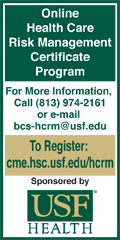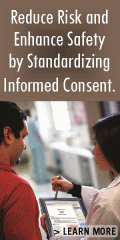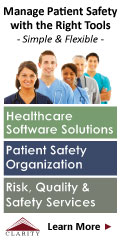 |
 |
 |

November / December 2006

AHRQ
TeamSTEPPS:
Integrating Teamwork Principles into Healthcare Practice
By Carolyn M. Clancy, MD

and David N. Tornberg, MD, MPH
We appreciate this opportunity to tell you about an outstanding new resource for training healthcare providers in better teamwork practices, developed jointly by the Department of Defense (DoD) and the Agency for Healthcare Research and Quality (AHRQ) — TeamSTEPPS, which stands for Team Strategies and Tools to Enhance Performance and Patient Safety. The new training package capitalizes on DoD's years of experience in medical and nonmedical team performance and AHRQ's extensive research in the fields of patient safety and healthcare quality. Following extensive field testing in the Military Health System (MHS) and several civilian organizations, a multimedia TeamSTEPPS toolkit is now available in the public domain to civilian healthcare facilities and medical practices.
Background — Teamwork and Team Training in Healthcare
In an editorial published in April 2005, Paul M. Schyve, M.D., senior vice president of the Joint Commission on Accreditation of Healthcare Organizations (JCAHO), observed:
Most healthcare today is delivered by teams — certainly in settings such as hospitals, nursing homes, and clinics, but also in most physicians' offices. Our challenge, therefore, is not whether we will deliver care in teams but rather how well we will deliver care in teams.
In a more recent article, Allan S. Frankel, M.D., and colleagues (2006) noted: "Currently, we can assure our patients that their care is always provided by a team of experts, but we cannot assure our patients that their care is always provided by expert teams."
Effective teamwork depends on individual team members' ability to:
- Anticipate the needs of others.

- Adjust to each other's actions and the changing environment.

- Have a shared understanding of how a procedure or plan should be carried out.

- Communicate efficiently.

- Enlist the patient's participation as part of the team (when appropriate).
Optimal teamwork does not automatically result from putting a group of people together in one place. It requires planning, cultivation, training, and practice. A science of teamwork has evolved over the past 2 decades, and "high risk" fields such as aviation, nuclear power, and the military embraced formal team training based on this science early on.
Healthcare professionals are rarely trained together. Instead, they are trained to function as individuals in hierarchical arrangements. Partly as a result, healthcare has only recently begun to realize the full benefits of the science of teamwork.
Recent increased attention to medical teamwork is, in large part, the result of the publication of the Institute of Medicine's (IOM's) report, To Err Is Human: Building a Safer Health System (2000). One of the principal findings of that report was that systemic failures in the delivery of healthcare account for more errors than does poor performance by individuals. Because systemic successes and failures depend to a great extent on the performance of teams, it was only logical for the IOM to recommend interdisciplinary team training to increase patient safety and quality healthcare.
Since the IOM report, a variety of other organizations have taken action to support improved teamwork and team training. For example, the Accreditation Council for Graduate Medical Education (ACGME) has identified six core competencies of graduate medical education, one of which is "interpersonal and communication skills," requiring residents to demonstrate skills that "result in effective information exchange and teaming with...professional associates." A number of medical specialties, including emergency medicine, obstetrics, and anesthesiology, have also developed tools to enhance team performance.
General Design of TeamSTEPPS
TeamSTEPPS offers a flexible, evidence-based toolkit, designed for healthcare facilities and providers, to improve patient safety through enhanced communication and other teamwork skills. The program is not just a one-shot training session that any healthcare provider can implement — integrating teamwork principles into practice involves much more than a single learning session. A TeamSTEPPS initiative occurs in three continuous phases: (1) assessment; (2) planning, training, and implementation; and (3) sustainment. Each phase incorporates key actions: set the stage, decide what to do, make it happen, and make it stick (Kotter & Rathgeber, 2006).
To develop TeamSTEPPS, an expert panel leveraged 20 years of research and lessons learned from the military and aviation sectors with input from more than 35 healthcare-related organizations. The curriculum was designed to address the requirements set by the DoD's Healthcare Team Coordination Program. TeamSTEPPS can be tailored for any healthcare setting. The curriculum was developed to address requirements set by DoD's Health Care Team Coordination Program and to meet the overall needs of the MHS as well as the civilian healthcare system. It was designed to train healthcare professionals who work not only in high-stress situations — such as surgical suites, emergency departments, and intensive care units — but also in ambulatory care settings, including physicians' offices. The TeamSTEPPS toolkit details the roadmap for creating change and shifting toward a stronger culture of safety.
The TeamSTEPPS curriculum has many attractive features. To begin, it is research-based and has been field-tested in the MHS. Ultimately, it will be implemented throughout the entire MHS — which is comprised of more than 450 Military Treatment Facilities worldwide that provide health services to more than 9.3 million active-duty military personnel, retirees, and family members. It was adopted by the MHS following years of experience with other team training models, making use of both the positive and negative lessons of that experience. It offers a multifaceted, multimedia instructional model, including classroom teaching, PowerPointTM presentations, videos, role playing, case studies, coaching exercises, and a handy pocket guide. In the interest of efficiency, it is based on a "train-the-trainer" model, allowing it to be adopted expeditiously in large organizations. The TeamSTEPPS toolkit is also readily adaptable to the needs and circumstances of individual healthcare delivery systems — and even those of individual teams.
Those who developed TeamSTEPPS were acutely aware that team training takes place in an environment where clinicians face many demands on their time and may not always be open to participating in team training. Because of this, the curriculum is arranged to make the most efficient use of clinicians' time and ultimately promises to make their daily work simpler, safer, and easier.
Those who designed the new toolkit were also attuned to the dynamics of many healthcare settings and teams, including staff turnover. (In the MHS, for example, it is estimated that more than one-third of staff permanently relocate annually) (Alonso et al.). They also recognized the need for reinforcement of lessons learned in TeamSTEPPS, providing simple tools, such as mnemonics and a condensed pocket guide to help clinicians remember the most important elements of the curriculum. The entire curriculum, individual modules, or one teamwork tool can be the focus of periodic refresher training or given to accommodate new staff and team members.
Elements of TeamSTEPPS
TeamSTEPPS is based on four core competency areas:
- Team leadership — the ability to direct and coordinate activities of team members, assess team performance, assign tasks, develop team knowledge and skills, motivate team members, plan and organize, and establish a positive team atmosphere.

- Situation monitoring (or mutual performance monitoring) — the capacity to develop common understandings of the team environment and apply appropriate strategies to monitor teammate performance accurately.

- Mutual support (or back-up behavior) — the ability to anticipate other team members' needs and to shift workload among members to achieve balance.

- Communication — including the efficient exchange of information and consultation with other team members.
The TeamSTEPPS toolkit incorporates a number of useful strategies. It is meant to encourage situational awareness and communication by all members of the team and to foster mutual respect among team members, regardless of their roles. For example, the Two-Challenge Rule sets guidelines for challenging a professional opinion or action, encouraging team members whose initial assertions are ignored to express their concern at least twice to assure that they have been heard. A mnemonic, SBAR ("Situation, Background, Assessment, and Recommendation"), offers a standardized framework for communicating critical information.
The actual physical components of the TeamSTEPPS toolkit include:
- The Instructor Guide.

- PowerPointÅ presentations, conveying the basic TeamSTEPPS principles to trainees.

- Implementation Guide with measurement tools.

- A CD-ROM, containing files of TeamSTEPPS training materials, allowing users to adapt the training to their own particular circumstances.

- A DVD, including nine video scenarios demonstrating how failures in teamwork and communications can place patients in jeopardy, and how successful teams would deal with these scenarios.

- Evidence-based summaries, each with an extensive bibliography.

- A compact Pocket Guide, summarizing TeamSTEPPS principles in a portable, ready-reference format.
Availability of the TeamSTEPPS Toolkit
The TeamSTEPPS toolkit can be obtained from various sources. First, it can be previewed on the Web site of DoD's Uniformed Services University of the Health Sciences (USUHS), http://www.usuhs.mil/cerps/teamstepps.html. Second, the electronic version (a CD-ROM and DVD, packaged as the Multimedia Curriculum Kit) is available at no charge from the AHRQ Publications Clearinghouse (800-358-9295 or ahrqpubs@ahrq.hhs.gov). Single copies of the entire TeamSTEPPS toolkit — including a binder containing all the printed materials and the Multimedia Kit — can be obtained through the AHRQ Publications Clearinghouse at cost. Copies of the complete binder kit can also be purchased from the U.S. Government Printing Office (www.gpo gov). Multiple copies of the Pocket Guide (in sets of 10) are also available from the GPO.
AHRQ and DoD are committed to assuring that TeamSTEPPS receives the widespread, high-level attention it deserves and that the team training toolkit is made available and adopted in as many healthcare settings as possible nationwide. We urge you to learn more about TeamSTEPPS by visiting the USUHS website (http://www.usuhs.mil/cerps/teamstepps.html) and to consider implementing TeamSTEPPS to create a safety net in your healthcare organization.
Carolyn Clancy is director of the Agency for Healthcare Research and Quality. She may be contacted at Carolyn.Clancy@ ahrq.hhs.gov.
David Tornberg is deputy assistant secretary of defense for clinical and program policy and the chief medical officer of TRICARE Management Activity.
References
Accreditation Council on Graduate Medical Education. Outcome project: Assessing residency education through outcomes assessment. http://www.acgme.org/Outcome.
Alonso, A., Baker, D. P., Holtzman, A., Day, R., King, H., Toomey, L., et al. (in press). Reducing Medical Errors in the Military Training System: How Can Team Training Help? Human Resource Management Review.
Frankel, A. S., Leonard, M. W., & Denham, C. R. (2006). Fair and just culture, team behavior, and leadership engagement: The tools to achieve high reliability. Health Services Research, 41(4, Part II), 1690-709.
Institute of Medicine (IOM).(2000). To err is human: Building a safer health system. L. T. Kohn, J. M. Corrigan, & M. S. Donaldson (Eds.). Washington, DC: National Academy Press.
Kotter, J., & Rathgeber, H. (2006). Our iceberg is melting: Changing and succeeding under any conditions. New York: St. Martin's Press.
Schyve, P. M. (2005). Editorial: The changing nature of professional competence. Joint Commission Journal on Quality and Patient Safety, 31(4), 185-202.
|
 |
 |
 |


















|
 |



